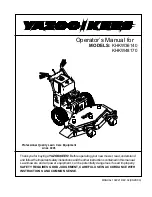
7 - 3
7 Electrical System Service
General Information
Cranking System
THE CRANKING SYSTEM IS COMPOSED OF:
the ignition switch, the safety interlock switches, the PTO
switch, the solenoid, and the starter.
CRANKING SYSTEM CURRENT PATH:
1. Current travels from the battery through the circuit
breaker, through the ignition switch, through the safe-
ty switches and PTO switch, to the solenoid.
2. If all safety conditions are met, the safety interlock
switches allow current to pass through the solenoid,
activating the solenoid.
4. The activated solenoid sends power to the starter,
cranking the engine.
Safety Interlock System
The safety system can be divided into two sub-systems:
1) the Operator Present sub-system and
2) the Safety Starting sub-system.
1) OPERATOR PRESENT SUB-SYSTEM
The operator present sub-system grounds the engine
ignition module (killing the engine) if the operator leaves
the seat with the parking brake disengaged (brake pedal
up) or the PTO engaged.
The operator can leave his/her seat with engine running
ONLY if ALL of the following conditions are met:
Hydro Models
-the PTO disengaged, AND
-the parking brake engaged.
Gear Models
-the PTO disengaged, AND
-the parking brake is engaged.
2) SAFETY STARTING SUB-SYSTEM
The safety starting sub-system will prevent the engine
from cranking if the PTO is ON or the parking brake is
disengaged. On gear models the safety starting system
will also prevent cranking if the ground speed control
lever is out of neutral.
The engine will crank ONLY if ALL of the following con-
ditions are met:
-the PTO is disengaged, AND
-the parking brake is engaged,
-(gear models only) AND the ground speed
control lever is in neutral.
CHECKING OUT THE SYSTEM
General
Both the ignition and charging systems are internal to the
tractor engine. Follow the Troubleshooting Guide,
Section 2, or refer to your engine manual for information.
See an authorized dealer or appropriate service manual
for additional engine troubleshooting information.
Basic Electrical Terms:
“Ground” is the negative battery post or any other con-
ductive part of the frame. For best results, use the nega-
tive battery post as ground.
“VOM” is a volt-ohm meter, multi-meter, or equivalent.
“VDC” is volts of direct current or the VOM setting used
to measure DC voltage.
“Ohms” are units of resistance or the VOM setting used
to measure resistance.
“Continuity” is a continuous, unbroken circuit. In this
manual continuity is determined with a VOM set to mea-
sure Ohms. Zero Ohms is true continuity. However, due
to contact point corrosion and resistance within wires,
continuity may measure a few Ohms.
“No Continuity” is a broken circuit. In this manual no
continuity is determined with a VOM set to measure
Ohms. No continuity will register as infinite Ohms.
“Battery Voltage” is the approximate voltage output of
the battery. Keep in mind that “battery voltage” tested at
any component will be slightly lower than “battery volt-
age” tested at the battery terminals due to resistance
within connections and wires.
Summary of Contents for AGCO Allis 500 Series
Page 1: ......
Page 18: ...1 16 1 General Information Notes...
Page 24: ...2 Troubleshooting Notes 2 6...
Page 36: ...3 Maintenance Maintenance Records 3 12...
Page 46: ...4 Adjustments Notes 4 10...
Page 104: ...8 Steering Component Service Notes 8 10...
Page 120: ...9 Drive Controls Service Notes 9 16...
Page 136: ...10 Transmission Removal Installation Notes 10 16...
Page 138: ...11 Transmission Teardown Notes 11 2...
Page 142: ...11 Transmission Teardown Notes 11 6...
Page 164: ...11 Transmission Teardown Notes 11 28...
Page 174: ...13 Seat Seat Deck Service Notes 13 6...
Page 178: ...14 PTO Clutch Service Notes 14 4...
















































